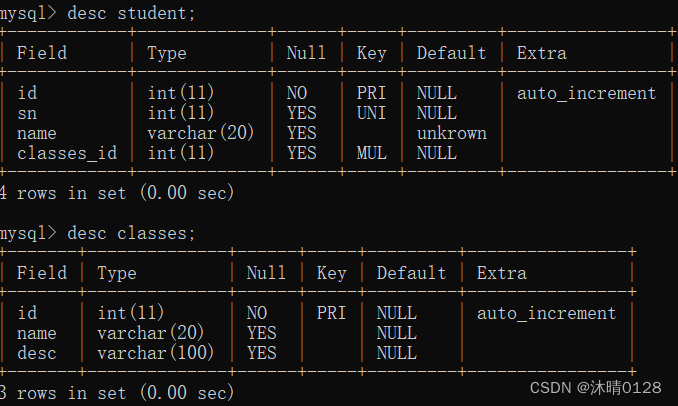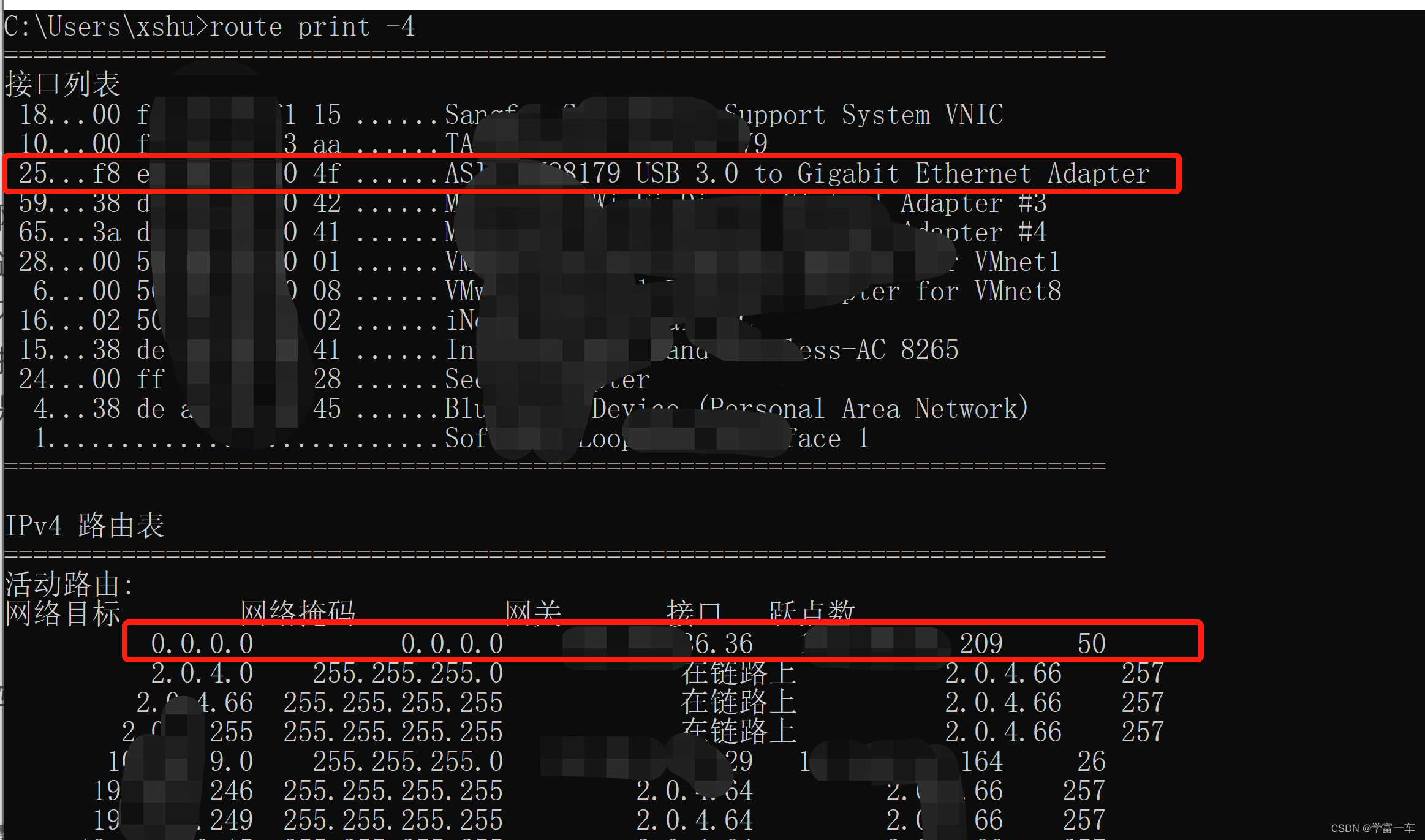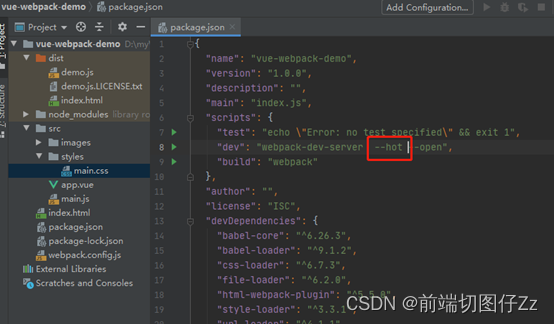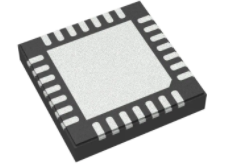目录
1.约束
1.1null约束
1.2唯一约束
1.3默认值约束
1.4主键约束
1.5外键约束
2.新增
3.查询
3.1聚合查询
3.1.1.聚合函数
3.1.2group by子句
3.1.3 having
3.2联合查询
3.2.1内连接
3.2.2外连接
3.2.3 自连接
3.2.4子查询
3.2.5合并查询
1.约束
1.1null约束
语法
create table 表名( 列名 类型 not null);
指定某列不能存储null值--必填项
create table student(id int not null,sn int,name varchar(20));
1.2唯一约束
语法
create table 表名( 列名 类型 unique);
先查询,看数据是否存在,如果存在,则插入/删除失败,如果不存在,则能插入/删除
create table student(id int not null,sn int unique,name varchar(20));sn用unique约束,sn的值则唯一,已经插入sn=1时,再次插入sn=1会插入失败
mysql> insert into student values(1,1,'wang');
Query OK, 1 row affected (0.00 sec)
mysql> insert into student values(2,1,'wan');
ERROR 1062 (23000): Duplicate entry '1' for key 'sn'1.3默认值约束
语法
create table 表名( 列名 类型 default '默认值')
insert指定列插入,其他未被指定到的列就按默认值填充
create table student(id int not null,sn int unique,name varchar(20) default'unkrown');name用默认值约束,当name列为空时,用默认值unkrown填充
insert into student(id,sn) values(2,2);+----+------+---------+
| id | sn | name |
+----+------+---------+
| 1 | 1 | wang |
| 2 | 2 | unkrown |
+----+------+---------+
1.4主键约束
语法
create table 表名( 列名 类型 primary key);
特点:
1.唯一,不为空, 一个表一个主键
2.可以是一个列,可以是多个列
3.主键是not null和unique的结合,可以不用not null
create table student(id int not null primary key,sn int unique,name varchar(20));+-------+-------------+------+-----+---------+-------+
| Field | Type | Null | Key | Default | Extra |
+-------+-------------+------+-----+---------+-------+
| id | int(11) | NO | PRI | NULL | |
| sn | int(11) | YES | UNI | NULL | |
| name | varchar(20) | YES | | NULL | |
+-------+-------------+------+-----+---------+-------+
自增主键:整数类型的主键,可以搭配auto_increment使用.当插入的数据对应字段没有值时,为最大值+1
列名 类型 primary key auto_increment;mysql> insert into student values(1,1,'wang');
mysql> insert into student(sn,name) values(2,'li');+----+------+------+
| id | sn | name |
+----+------+------+
| 1 | 1 | wang |
| 2 | 2 | li |
+----+------+------+
1.5外键约束
外键用于关联其他表的主键或者唯一键
语法
foreign key(字段名) references 主表(列);创建班级表
CREATE TABLE classes (id INT PRIMARY KEY auto_increment,name VARCHAR(20),`desc` VARCHAR(100));
学生表,学生班级是一对多的关系,id为主键,classes_id为外键,关联班级表id
create table student(id int primary key auto_increment,sn int unique,name varchar(20) default'unkrown',classes_id int,foreign key(classes_id) references classes(id));student表中每一个记录的classid在classes表的id都存在
student收到classes的约束,把classes叫做student的父表,student是class的子表

2.新增
插入查询结果:查询结果,得到的列数,类型需要和插入表的列数,类型相同.(列名可以不同)
语法
insert into 表名A(...) select...from 表名B;把表名b中的信息复制到表名a中
3.查询
3.1聚合查询
3.1.1.聚合函数
1.count:计数
字段名中为null的数据不会计入结果
select count(字段名) from 表名;2.sum:求和
只对数字列有效,自动跳过结果为null的行
select sum(字段名) from 表名 (where ...);3.avg:平均值
select avg(字段名+..) (as) 别名 from 表名;4.max:最大值
select max(字段名) from 表名;5.min:最小值
select min(字段名) from 表名;3.1.2group by子句
对指定列先分组在查询
注:指定字段必须是分组依据字段,如果要有其他字段,必须要有聚合函数
select 字段名1, 聚合函数(字段名2),... from 表名 group by 字段名1,...;3.1.3 having
group by 分组后,不能用where ,要用having代替where
select 字段名1, 聚合函数(字段名2),... from 表名 group by 字段名1,...having ...;3.2联合查询
多表查询的步骤
1.分析清除需求中,涉及的信息在哪些表中
2.针对多个表进行笛卡尔积
3.筛选出其中有效数据(此处用学生id做关联条件)
4.结合需求中的条件,进行加强条件
5.针对列进行
3.2.1内连接
语法
1.join对两张表
select 字段 from 表1 (别名1) join 表2 (别名2) on 连接条件1;
select * from student join score on stsudent.id=score.student_id ;2.join对多张表
select 字段 from 表1 (别名1) join 表2 (别名2) on 连接条件1 join 表3 (别名3)
on 连接条件2)...;
select * from student join score on stsudent.id=score.student_id join course on course.id=score.course_id;3.2.2外连接
外连接分为左外连接和右外连接。如果联合查询,左侧的表完全显示我们就说是左外连接;右侧的表完全显示我们就说是右外连接。
语法
1.join对两张表
左外连接:select 字段 from 表1 (别名1) left join 表2 (别名2) on 连接条件1;
右外连接:select 字段 from 表1 (别名1) right join 表2 (别名2) on 连接条件1;
左连接:select * from student left join score on stsudent.id=score.student_id ;
右连接:select * from student right join score on stsudent.id=score.student_id ;2.join对多张表
左外连接:select 字段 from 表1 (别名1) left join 表2 (别名2) on 连接条件1 join 表3 (别名3) on 连接条件2)...;
右外连接:select 字段 from 表1 (别名1) right join 表2 (别名2) on 连接条件1 join 表3 (别名3) on 连接条件2)...;
左外连接:select * from student left join score on stsudent.id=score.student_id left join course on course.id=score.course_id;
右外连接:select * from student right join score on stsudent.id=score.student_id right join course on course.id=score.course_id;注:内外连接的区别
1.内连接-->两个表中都体现的数据
select name,score from student join score on student.id=score.student_id;
+------+-------+
| name | score |
+------+-------+
| 张三 | 90 |
| 李四 | 80 |
+------+-------+2.左外连接,以左侧表为准,左侧表中的所有数据都能体现出来
select name,score from student left join score on student.id=score.student_id;
+------+-------+
| name | score |
+------+-------+
| 张三 | 90 |
| 李四 | 80 |
| 王五 | NULL |
+------+-------+3.右外连接,以右侧表为准,右侧表中的所有数据都能体现出来
select name,score from student right join score on student.id=score.student_id;
+------+-------+
| name | score |
+------+-------+
| 张三 | 90 |
| 李四 | 80 |
| NULL | 70 |
+------+-------+3.2.3 自连接
自连接是指在同一张表连接自身进行查询。(本质把行转换成列)-->实现行中的比较
自连接要指定表的别名
select * from 表名 as 别名1,表名 as 别名2(where...);
3.2.4子查询
子查询是指嵌入在其他sql语句中的select语句,也叫嵌套查询
- 单行子查询:返回一行记录的子查询
select 字段名1 from 表名1 where 字段名2 =(select 字段名3 from 表名2 where... )
字段名2和字段名3对应
字段名1,字段名2属于表名1
字段名3属于表名2
1.(not)in关键字
select 字段名1 from 表名1 where 字段名2 (not)in(select 字段名3 from 表名2 where... )
字段名2和字段名3对应
字段名1,字段名2属于表名1
字段名3属于表名2
2.(not) exists关键字
select 字段名1 from 表名1 where (not) exists(select 字段名3 from 表名2 where... )
字段名2和字段名3对应
字段名1属于表名1
字段名3属于表名2
- 在from子句中使用子查询:子查询语句出现在from子句中。这里要用到数据查询的技巧,把一个子查询当做一个临时表使用。
3.2.5合并查询
为了合并多个select的执行结果,可以使用集合操作符 union,union all.
使用UNION和UNION ALL时,前后查询的结果集中,字段需要一致。
1.union
该操作符用于取得两个结果集的并集。当使用该操作符时,会自动去掉结果集中的重复行。
select * from 表名1 where... union select * from 表名2 where...;
可以用or实现
select * from 表名1 where... or select * from 表名2 where...;
2.union all
该操作符用于取得两个结果集的并集。当使用该操作符时,不会去掉结果集中的重复行。
select * from 表名1 where... union all select * from 表名2 where...;
















![[python入门(53)] - python中的OS模块(包) - 2](https://img-blog.csdnimg.cn/0c9d831905e04789b4e5072422526b64.png)



